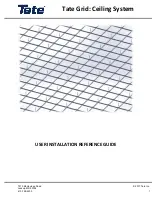
10
OPERATION
SAFETY INSPECTION
Introduction
Every day before operating the Turf Tender, it is important
to perform a safety inspection “walk around” of the Turf Tender.
The purpose of the safety inspection is to inspect the Turf
Tender for any unsafe conditions and maintenance concerns.
Finding these conditions before using the Turf Tender can
save time, money, and the possibility of injuries. Check for
loose nuts or bolts, broken or cracked metal and welds, bent
or damaged components, under-inflated tires and leaking
hydraulic components and hoses. Any of these conditions may
indicate a potentially serious situation.
Start the inspection at the handle. Check the handle for
excessive wear or cracks. Check to make sure the steering
moves smoothly from side to side and does not bind. Check
the operation of the engagement handle by squeezing it and
releasing it. Upon release it must return quickly and smoothly
to the OFF position.
Check the area around the engine and battery. Check for
any leaks. Check for any loose wires. Be sure the battery
cables are clean and tight. All wiring should be secured to the
Turf Tender and should not be hanging loose.
Check the left side of the Turf Tender for any unsafe
conditions. Check for any hydraulic leaks. Visually, make sure
the tire is inflated properly. If in doubt, use a tire gauge and
check the tire pressure. Check for loose hoses. All hoses should
be secured to the Turf Tender and should not be hanging loose.
At the back of the Turf Tender, continue to look for hydraulic
leaks and other unsafe conditions. Check the conveyor belt
for damage and proper alignment. Make sure the shield over
the twin spinners is not bent or interfering with the operation
of the spinners. Make sure the rear gate is not bent or damaged
and is closed as much as needed for the materials you will be
hauling. By hand, rotate each spinner to ensure that it is not
bent and clears other parts of the spinner/chute assembly.
On the right side of the Turf Tender, visually, make sure the
tire is inflated properly. Check for any signs of hydraulic leaks.
When finished with the safety inspection and any repairs
or adjustments that need to be made, the Turf Tender is ready
for operation. Make sure the parking brake lever is in the up
(disengaged) position.
SPREADING OPERATION
The 310 Turf Tender is meant to be operated in forward
while spreading. The correct operating position for the operator
is to be to the side of the handlebars (either left or right
dependent upon individual preference and ground terrain)
looking in the direction of travel. Once the engine has been
started, compressing the engagement handle will activate the
clutch on the engine and hydraulic power is available to the
three functions (spinners, conveyor, and travel). The speed of
each of these three functions is dependent upon the position
of the appropriate lever and the engine RPM. Remember that
engine rpm is determined by the position of the
engine speed
control switch
, Releasing the engagement handle disengages
the clutch and all functions stop.
Always use a travel speed that is safe. Do not travel at a
speed faster than you can safely operate.
WARNING
Only operate the Turf Tender at a speed you can
safely control.
NOTE: In order to move the travel lever from the
neutral position, press the knob downward.
Be sure to bring the Turf Tender to a complete stop before
making any adjustments that are not controlled by the levers.
WARNING
Do not walk backwards while operating. Always
watch where you are walking.
If an immediate shut down of the Turf Tender is desired or
necessary, press the
E-Stop
switch down to immediately turn
the engine off. When start-up is desired, pull the
E-Stop
upward
and go through normal start-up procedures.
OPERATION






































